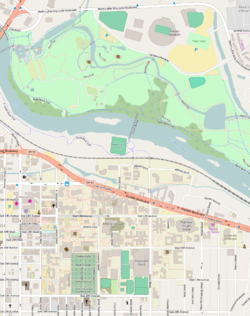
The University of Oregon is a public research university in Eugene, Oregon. Founded in 1876, the university also has two Portland locations, and manages a marine station, called the Oregon Institute of Marine Biology, in Charleston; and an observatory, called Pine Mountain Observatory, in Central Oregon.

The Field Museum of Natural History (FMNH), also known as The Field Museum, is a natural history museum in Chicago, Illinois, and is one of the largest such museums in the world. The museum is popular for the size and quality of its educational and scientific programs, and its extensive scientific specimen and artifact collections. The permanent exhibitions, which attract up to 2 million visitors annually, include fossils, current cultures from around the world, and interactive programming demonstrating today's urgent conservation needs. The museum is named in honor of its first major benefactor, Marshall Field, the department-store magnate. The museum and its collections originated from the 1893 World's Columbian Exposition and the artifacts displayed at the fair.
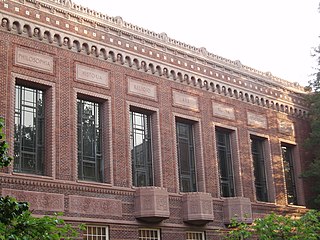
Knight Library is the main facility of the University of Oregon's (UO) library system. It is located on the university's campus in Eugene, Oregon, United States. The library design is emblematic of the architecture of the university's older buildings, and it serves as a hub of student activity. As of 2008 it has a collection of more than 3 million volumes. The library also holds collections of primary sources such as photographs and manuscripts on various topics at the Special Collections & University Archives. It is also a depository for the Federal Depository Library Program. The library was previously known as the Main Library and it was renamed the Knight Library in 1988, in honor of the family of Phil Knight.
William Oscar Hall was the U.S. Ambassador to Ethiopia from 1967 to 1971, during the reign of Emperor Haile Selassie I.

Thomas Condon (1822–1907) was an Irish Congregational minister, geologist, and paleontologist who gained recognition for his work in the U.S. state of Oregon.

Fort Rock Cave was the site of the earliest evidence of human habitation in the US state of Oregon before the excavation of the Paisley Caves. Fort Rock Cave featured numerous well-preserved sagebrush sandals, ranging from 9,000 to 13,000 years old. The cave is located approximately 1.5 miles (2.4 km) west of Fort Rock near Fort Rock State Natural Area in Lake County. Fort Rock Cave was declared a National Historic Landmark in 1961, and added to the National Register of Historic Places in 1966.

The Oregon Institute of Marine Biology is the marine station of the University of Oregon. This 100-acre (0.40 km2) marine station is located in Charleston, Oregon at the mouth of Coos Bay. Currently, OIMB is home to several permanent faculty members and a number of graduate students. OIMB is a member of the National Association of Marine Laboratories (NAML). In addition to graduate research, undergraduate classes are offered year round, including marine birds and mammals, estuarine biology, marine ecology, invertebrate zoology, molecular biology, biology of fishes, biological oceanography, and embryology.
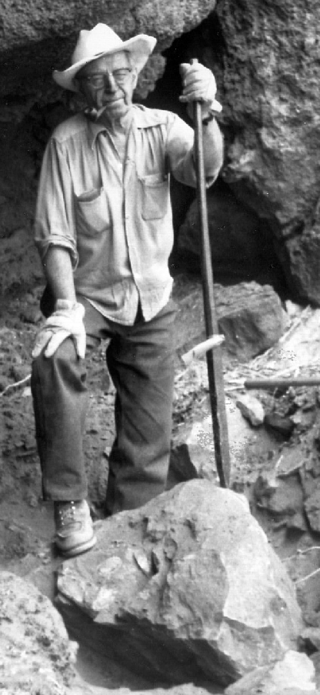
Luther Sheeleigh Cressman was an American field archaeologist, most widely known for his discoveries at Paleo-Indian sites such as Fort Rock Cave and Paisley Caves, sites related to the early settlement of the Americas.
Homer Garner Barnett was an American anthropologist and teacher.
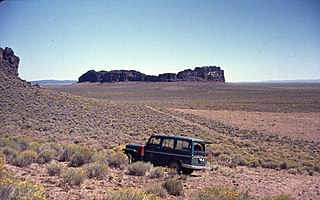
Fort Rock–Christmas Lake Valley is a basin of a former inland sea that existed in that region from Pliocene through late Pleistocene time.

The Idaho Museum of Natural History (IMNH) is the official state natural history museum of Idaho, located on the campus of Idaho State University (ISU) in Pocatello. Founded in 1934, it has collections in anthropology, vertebrate paleontology, earth science, and the life sciences. Additionally, it contains an archive of documents and ethnographic photographs.

The Paul H. Jensen Arctic Museum was a museum focused on the culture and environment of the Arctic in Monmouth in the U.S. state of Oregon. Located on the campus of Western Oregon University (WOU), the museum opened in 1985 with 3,000 artifacts collected by its late founder and namesake. The museum housed 5,000 artifacts and had exhibits on the wildlife of the Arctic along with displays that demonstrate the culture of the Inuit and Eskimo peoples of Alaska. The museum was one of only two museums focused on life in the Arctic located in the lower 48 states, and the only one on the West Coast. In 2013, WOU announced that the Jensen Museum would close its doors and the collections would move to the University of Oregon Museum of Natural and Cultural History (MNCH) at the University of Oregon in Eugene, which also has substantial Arctic collections.
Dennis L. Jenkins is a research archaeologist, field school supervisor for the Oregon State Museum of Anthropology/Museum of Natural and Cultural History at the University of Oregon, and director of the university's Northern Great Basin Field School. One of his excavations led to a new accepted date for earliest human settlement in the Americas. Jenkins' work on coprolites earned him the nickname Dr. Poop.
Jon M. Erlandson is an archaeologist, professor emeritus in the Department of Anthropology at the University of Oregon, and the former director of the University of Oregon Museum of Natural and Cultural History. Erlandson’s research interests include coastal adaptations, the peopling of North America, maritime archaeology and historical ecology and human impacts in coastal ecosystems.

Paleontology in Oregon refers to paleontological research occurring within or conducted by people from the U.S. state of Oregon. Oregon's geologic record extends back approximately 400 million years ago to the Devonian period, before which time the state's landmass was likely submerged under water. Sediment records show that Oregon remained mostly submerged until the Paleocene period. The state's earliest fossil record includes plants, corals, and conodonts. Oregon was covered by seaways and volcanic islands during the Mesozoic era. Fossils from this period include marine plants, invertebrates, ichthyosaurs, pterosaurs, and traces such as invertebrate burrows. During the Cenozoic, Oregon's climate gradually cooled and eventually yielded the environments now found in the state. The era's fossils include marine and terrestrial plants, invertebrates, fish, amphibians, turtles, birds, mammals, and traces such as eggs and animal tracks.

Fossil Lake is a dry lakebed in the remote high desert country of northern Lake County in the U.S. state of Oregon. During the Pleistocene epoch, Fossil Lake and the surrounding basin were covered by an ancient lake. Numerous animals used the lake's resources. Over time, the remains of many of these animals became fossilized in the lake sediments. As a result, Fossil Lake has been an important site for fossil collection and scientific study for well over a century. Over the years, paleontologists have found the fossil remains of numerous mammals as well as bird and fish species there. Some of these fossils are 2 million years old.
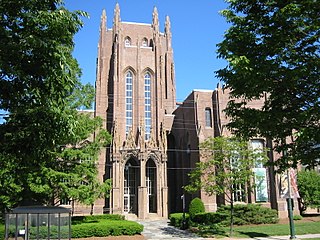
The Peabody Museum of Natural History at Yale University is one of the oldest, largest, and most prolific university natural history museums in the world. It was founded by the philanthropist George Peabody in 1866 at the behest of his nephew Othniel Charles Marsh, an early paleontologist. The museum is best known for the Great Hall of Dinosaurs, which includes a mounted juvenile Brontosaurus and the 110-foot-long (34 m) mural The Age of Reptiles. The museum also has permanent exhibits dedicated to human and mammal evolution; wildlife dioramas; Egyptian artifacts; local birds and minerals; and Native Americans of Connecticut.
Gertrude Bass Warner was an American twentieth-century art collector, with particular interests in Asian art, religious artifacts, daily-life textiles, ceramics, paintings, and photographs. She lived, traveled, and collected art in East Asia from 1904 to 1938. In 1922 she became the curator for life and first director of the University of Oregon Museum of Art at the University of Oregon, helping to design the historic building with famed architect Ellis F. Lawrence. She had the museum built to house the collection of more than 3,700 works of art, the Murray Warner Collection of Oriental Art, named after her late husband, Murray Warner. She donated the collection to the university in 1933. She traveled throughout China, Japan, Korea, and Russia purchasing works of art and artifacts, taking photographs, and writing extensive field notes. She visited thousands of cultural sites and studied Shinto, Buddhism, and Chinese and Japanese etiquette, and the human experience, and became an innovator in the promotion of Asian art and culture appreciation, Asian studies, and multiculturalism. She is considered a female pioneer of museum studies.

Scott M. Fitzpatrick is a Professor in the Department of Anthropology and Curator of Indo-Pacific Archaeology at the Museum of Natural and Cultural History at the University of Oregon. He is a specialist in the prehistory and historical ecology of island and coastal regions of the Pacific and Caribbean. His research has focused on colonization events, seafaring strategies, adaptations to smaller islands, exchange systems, and human impacts on ancient environments. He has conducted archaeological research in the Caribbean and Pacific Islands with other projects having taken place in Panama, the Florida Keys, and Oregon Coast. He has published several books and more than 140 journal articles and book chapters. Fitzpatrick is the founding co-editor of The Journal of Island and Coastal Archaeology, an Associate Editor for Archaeology in Oceania, a Review Editor for Frontiers in Human Dynamics, and serves on the editorial boards for the Caribbean Journal of Science and Journal of Archaeological Science: Reports. Fitzpatrick is also a Research Associate at the National Museum of Natural History, Smithsonian Institution and a Research Affiliate at the Florida Museum of Natural History.

